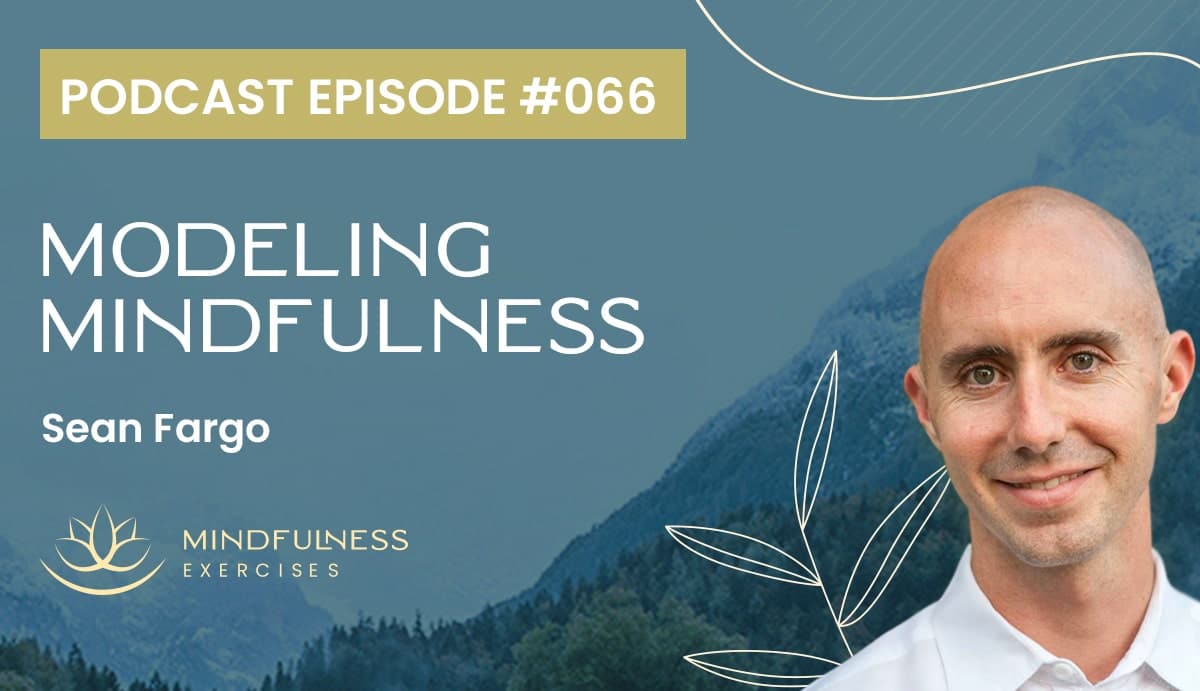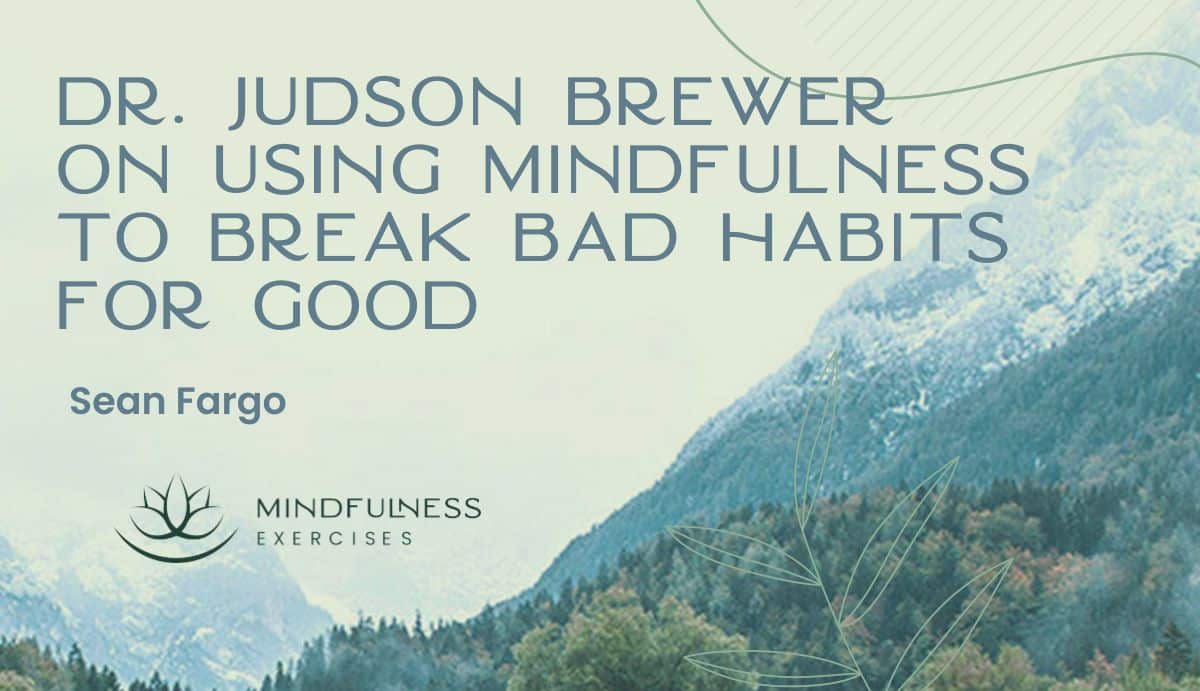Listen now

We are always modeling behavior for others, whether we are aware of it or not. We can choose to model a mindful way of being. When we embody mindful presence, we radiate a stable, calm energy that helps others feel safe and gives them permission to be their most authentic selves.
In this episode we hear from Sean Fargo on what it means to model mindfulness, and how we can do so not only as mindfulness teachers, but as anyone with an interest in helping others feel supported and accepted.
This talk is a brief excerpt of Sean Fargo’s weekly mentorship session for those enrolled in our Mindfulness Meditation Teacher Training Program. Learn more about this unique, online, self-paced certification program at mindfulnessexercises.com/certify
What You’ll Learn in This Episode:
Show Notes:
The impact we have on those around us
We know from experience that a single person can have a negative impact on everyone around them. But this capacity to influence can be a good thing, too. Just one person, by embodying mindful presence, stability, calm or confidence, can positively impact everybody in their orbit. This is important for us to remember not only as mindfulness teachers, but in each of our relationships, whether as leaders, as parents or as friends.
“One person can make a huge impact on those around them. As mindfulness teachers, a lot of how we teach is by how we are. [...] This is the grounds for expressing love.”
How presence creates a feeling of safety
Our acceptance of the present moment, just as it is, can help others feel safe in our presence. When we model non-judgment and a caring acknowledgement of what is actually here, we signal to others that it’s okay for them to be here with us as their most authentic, most vulnerable selves.
“That feeling of safety will arise more than if we just use certain words, or say that it’s okay. Can we model it? And some of that is just being authentic yourself, sharing your own difficulties, really being humble, remembering the common humanity of this.”
The importance of strengthening our personal practice
Our ability to remain grounded, calm and open-hearted, especially in difficult situations, is directly related to the strength of our personal practice. We can only serve as a beneficial source of co-regulation if we have done the work that allows us to remain embodied in the face of discomfort. This work begins with mindfulness of the body.
“We’re strengthening the muscle of bodily awareness the more we practice it. We’re building the insula in the brain that’s responsible for proprioception, being able to sense into visceral sensations, opening to energies in and around the body. And the more we practice this, the more we actually sense, the more we notice, the more we feel, the more sensitive we become.”
Mindfulness of the body as the primary foundation of mindfulness
True mindfulness is more than an awareness of the world around us. In fact, it begins when we are capable of being fully present in our own body, with each of our senses and the energy of our emotions. Mindfulness and awareness are not merely functions of the cognitive mind; they necessitate an embodied experience.
“The mind itself encapsulates the body. Mindfulness is not brainfulness. Mindfulness is not headfullness. The mind encapsulates our whole sensory apparatus, including our nervous system, and our heart. So, if we are embodying mindfulness, are we mindful of our body? (Are we) including the body in our awareness?”
Bringing mindfulness to the body as we teach
When teaching, or simply when present with others, we can sometimes get caught up in the energy of the people around us. It can be easy to lose connection to ourselves. Part of our practice, then, is to see if we can maintain awareness of others while simultaneously being mindful of our own experience, our own body. By doing so, we can encourage others to do the same.
“It’s not easy, but my point is to stay in the body. Stay embodied with this non-judgmental moment-to-moment awareness. When we’re embodying mindfulness, we’re embodying non-judgemental presence. So, can we refrain from judgments of ourselves, or the situation, or our students? And that’s not easy. But the more mindful we are, the more we notice the judgments arising, and the more we can be with that.”
Holding space for suffering
Often, we are interested in sharing mindfulness with others because we want to help people heal, grow and change. This, along with our own discomfort with pain, can make it challenging to hold space for suffering, to be with it versus avoiding or pushing it away. These uncomfortable moments, however, are an opportunity for us to model allowance, acceptance, and an embodied presence, no matter what is arising. In lieu of attempting to fix or offer advice, what if we offered caring presence?
“As a mindfulness teacher, a lot of what we’re encouraging is just to be. [...] We’re not judging, we’re not forcing, we’re not fixing, we’re just being with this too. So, remembering it’s not about all the words that we use, or what models of growth we’re using. Most of it, in my opinion, is just being with this, including the suffering. [...] The nature of mindfulness is to take a back seat and notice what’s here.”
Modeling authenticity when guiding meditations
Part of our role as mindfulness teachers is to help others detach from outcomes or the need for perfection to precede happiness. It benefits us, then, to be aware of how perfection or attachment to outcome arises as we teach. One way to soften around this is to speak more from the heart than the head, to model authentic connection to what’s deep within us.
“And so with guiding meditations, can we model what we’re guiding by loosening the script a little bit, softening around what we think we should say, or detaching ourselves from this viewpoint of ‘What's best way to guide this or the right way to guide this?’ But just speak more from the heart. [...] Just encourage myself and them to notice what’s here.”
Additional Resources:

About Sean Fargo:
Sean Fargo is a former Buddhist monk and the founder of Mindfulness Exercises. The online platform, which has shared free and premium mindfulness resources with over 3 million people worldwide, has now certified over 500 Mindfulness Teachers.
Sean is the lead instructor for the teacher training program, a unique self-paced approach which invites world-renowned mindfulness teachers to share their insights and experiences. Sean has taught mindfulness and meditation for corporations including Facebook, Google and Tesla and for health and government organizations, prisons and hospitals around the world.






